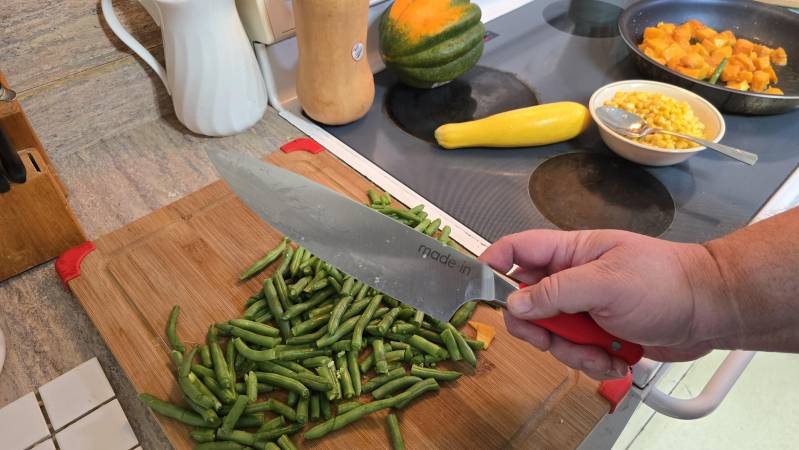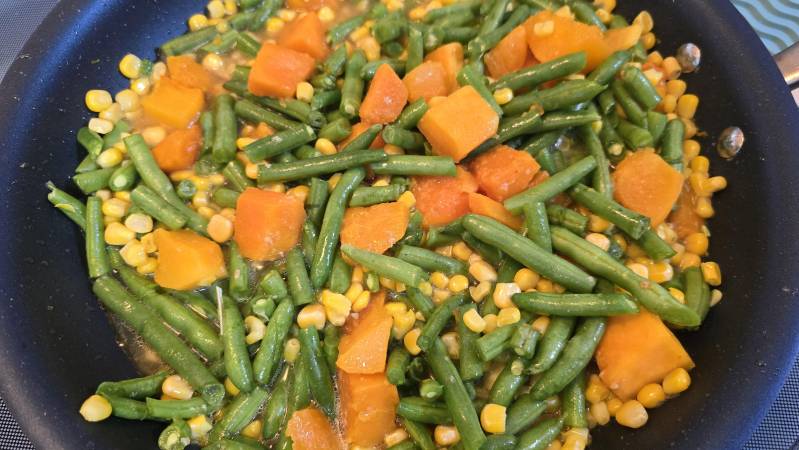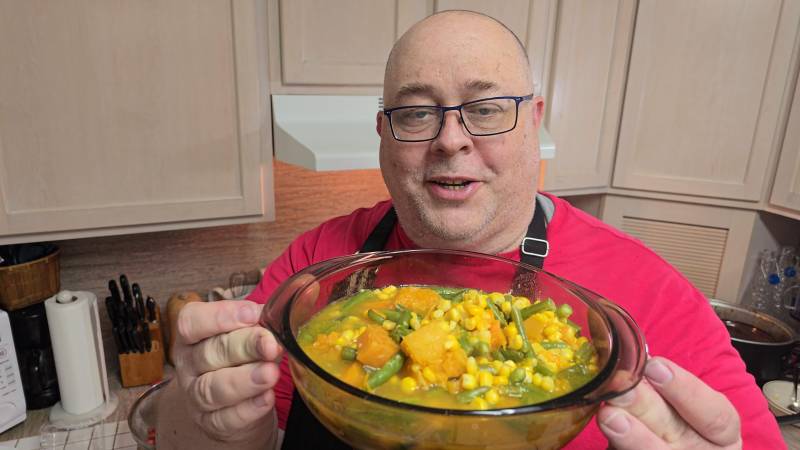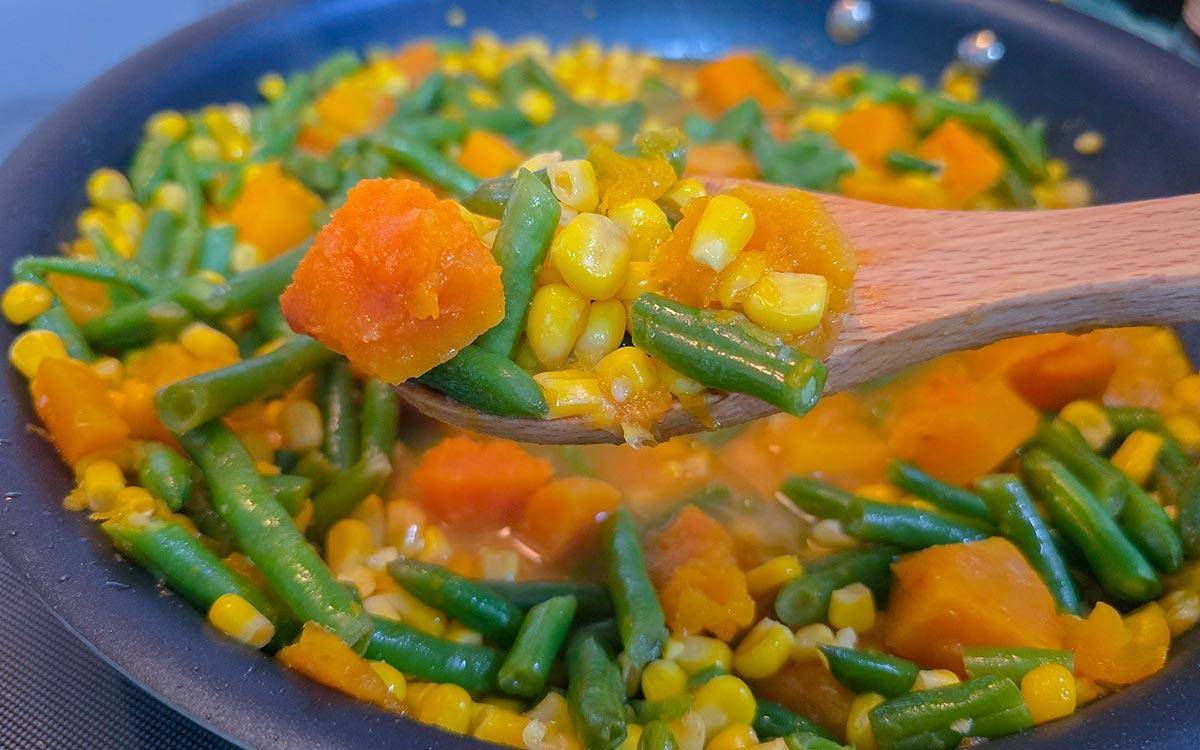I'm not going to pretend that this is a fully accurate and 100% authentic Wampanoag succotash recipe but I've done my best to create something that matches their culinary traditions and food availability before the Pilgrims arrived in 1620. This journey, along with some others that I've done recently to better understand indigenous traditions among the peoples that inhabited North America for thousands of years, is a thrilling journey of exploration for me. It's one thing to simply visit Plymouth Rock or talk with a tribal historian, but to actually prepare and taste something that someone hundreds of years did allows your mind and body to understand a culture far better than any history book ever will.
I've been passionate about exploring indigenous foods and cultural exploration of culinary traditions for a while now. Whether it's visiting restaurants like Kekuli Cafe in Kelona, BC or enjoying a meal at the Indian Pueblo Kitchen at the Cultural Center in Albuquerque, NM ... it's simply not the same as cooking it yourself and sharing the journey with your friends and family. So I encourage each of you to try this recipe or the one we prepared for our similarly authentic Cranberry Maple sauce and use this opportunity to talk about the history and heritage of America's first peoples.
This recipe was prepared to honor and celebrate Native American Heritage Day, but it's something that men (and women) of all ages should consider at any time of the year. While many of us spend thousands of dollars to travel to exotic places and explore fascinating cultures ... but how many of you take the time to listen, learn, and try something from one of the great cultures that were here in North America before the Europeans arrived?
Similarly, while the native Americans that inhabited New England traded with each other and often shared a similar culture, they had their own unique traditions. This list includes the following tribes as well as various smaller bands.
- Wampanoag: Massachusetts and Rhode Island coastal regions
- Nauset: Cape Cod area
- Narragansett: Southern New England coast
- Pequot: Connecticut coastal region
- Mohegan: Connecticut coastal region
- Abenaki: Northern New England (Vermont, New Hampshire, Maine)
- Penobscot: Coastal Maine, primarily along the Penobscot River
- Passamaquoddy: Coastal Maine, particularly around Passamaquoddy Bay
- Mi'kmaq: Nova Scotia, New Brunswick, Prince Edward Island, and parts of Maine
Each of these groups shared a similar diet but would have likely had significant variations in how they prepared something like succotash ... a dish which is essentially a vegetable stew.
That said, it's time to dive in and create some amazingly delicious succotash. I've created this recipe based on my own historical research, using ingredients that are as historically accurate and culturally authentic as possible!
The journey to recreate historical recipes is both challenging and enlightening. During the process, I faced several challenges while attempting to reproduce dishes like this from more than 400 years ago. However, I'm pretty confident that this traditional Wampanoag succotash is similar enough to what was shared with the Plymouth settlers that there would be no complaints then .. or now.
Unfortunately, many of the ingredients available to us today are quite different from their 17th-century counterparts - modern corn varieties have been extensively cultivated for sweetness, while heritage beans and squash varieties have largely given way to modern cultivars.
While we might be tempted to enhance this dish with contemporary seasonings like salt and pepper, there's value in experiencing these foods as they might have been prepared in 1621. This approach allows us to better understand and appreciate the subtle flavors of the core ingredients and honors the culinary wisdom of the Narraganset and Wampanoag people who first created this nourishing dish.

Europeans Brought Ingredients That Added Diversity
If you search online, you will find hundreds of "authentic" succotash recipes and frankly speaking, many of them are truly authentic ... it just depends on where you draw the line. For instance, many ingredients that I see included in different recipes, such as salt and pepper, onions, herbs, and spinach, aren't fully authentic to pre-European Wampanaog in what is today coastal Massachusettes. Similarly, I've seen recipes for "Wampanoag Succotash" that don't include corn when the word is literally derived from the Narragansett tribe - Sohquttahhash or sometimes msickquatash - a word that literally means "broken corn kernels."
As more settlers arrived in what is today "New England" they introduced various European ingredients while adapting foods that were once enjoyed by the indigenous people here. As such, this once authentic dish has been adapted to include many ingredients that the people living in coastal New England around 1600 simply wouldn't recognize.
Similarly, culinary essentials like butternut squash and other ingredients we now identify as Native American food staples, weren't really native to this area either. However, over the more than 10,000 years that humans populated Eastern Massachusetts, trade networks evolved, and tasty foods were traded among different tribes throughout the Americas.
Ultimately, my advice to any of you guys reading this is to take this as a culinary history lesson and embrace the dish's hundreds of years of evolution. If you want to add lima beans ... do it! If you want to add in onions, have at it! Salt, pepper, okra, etc. it's all on the table for you to take the next step evolving the dish to meet your family's tastes and traditions. Heck, I've even seen recipes that included corned beef and sausages.
Though we cannot perfectly recreate the exact ingredients used in 1621 - as many heritage varieties are now rare or extinct - we can still capture the essence of this historical dish by using similar ingredients and traditional cooking methods. This recipe attempts to stay as true as possible to the original preparation while acknowledging that some substitutions are necessary for modern cooks.

Ingredients
- 2 cup chopped string beans
- 16 oz corn
- 16 oz butternut squash
- 3 ½ cups water
- 2 tablespoons of lard (not authentic, but good luck finding bear oil / bear grease at your local grocery!)
- 2-3 tablespoons of minced garlic
Preparation Instructions
I like to roast butternut squash to add a bit of extra smoky flavor so place the chopped squash in the pan and pan with the lard and roast them along with the garlic - once again, this is a great example of an ingredient that isn't entirely authentic (our garlic variety today evolved from one native to central Asia and was spread by Spanish explorers starting in the 1400s. It's possible that our cooks in 1600 had access to it but they almost certainly had a similar native species.)
Once the squash starts to get a bit brown on the edges and flesh turns slightly soft, add water, corn, and string beans.
Allow the mixture to simmer for about 20-30 minutes till the squash is completely soft and the starch from the corn begins to thicken the succotash a bit.
From here, feel free to add other flavorings if you want - such as salt, pepper, or even basic or oregano since those ingredients were certainly brought over by the folks that settled Plymouth Bay Colony. We've omitted butter since while goats, pigs, and chickens were brought on the Mayflower, cows and sheep were not brought from England until several years later. As such, lard (rendered from pig fat for cooking) is an authentic substitute for bear grease in this recipe.

When preparing this dish for a large family gathering like Thanksgiving or in honor of Native American Heritage Day, it works really well since it can be left covered on the stove at a low temperature while preparing other dishes for your fall feast. Similarly, it re-heats easily in the microwave, and you can even easily adapt the recipe to work with a slow cooker instead, making extra space in your kitchen for other dishes.
Once ready, serve hot, appreciating the natural flavors of this historical dish that helped sustain both the Wampanoag people and Pilgrims / Plymouth Bay Colony settlers!
